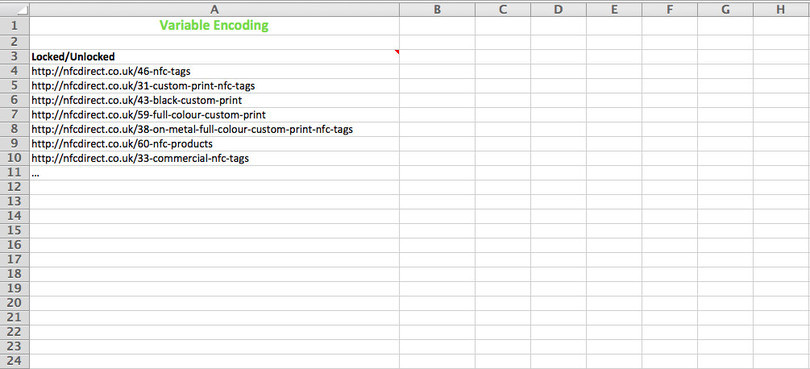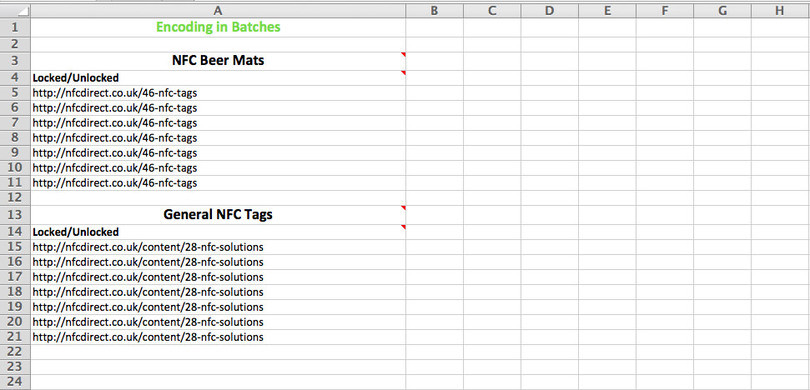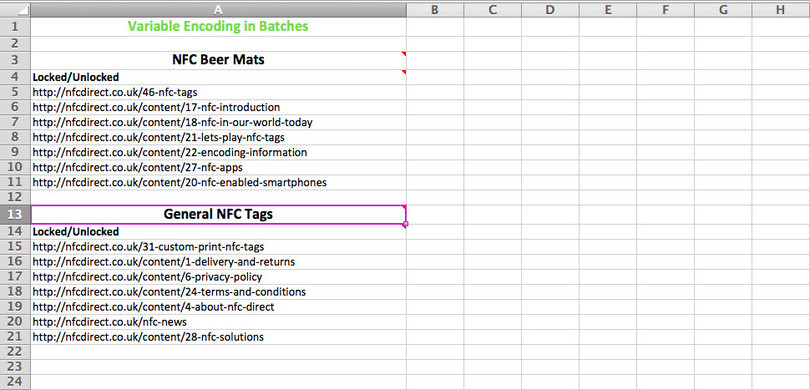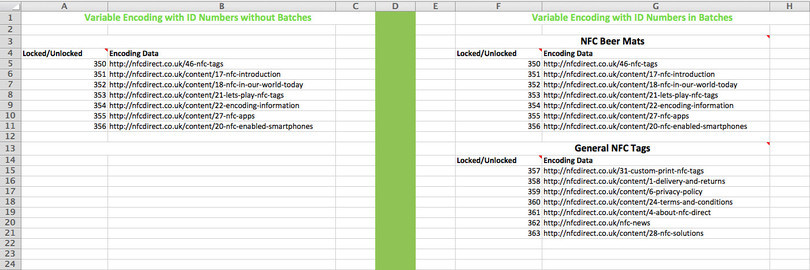NFC Encoding
Encoding NFC Tags/Products
If you have or are considering making an order and require an encoding template for your encoding data please download our Encoding Template
- Already familiar with how encoding works? Scroll down the page to 'Encoding with NFC Direct' to find out more about our encoding options and services.
- If you are unsure what you need and are looking for an NFC encoding introduction please read on…
What is Encoding?
NFC Contactless technology is – at its most basic – simply another way of storing and transferring information. Just like you can save data to a hard drive, USB stick or memory card, you can also save data to an NFC Tag/Product. This could be a web address, a name, a reference number, electronic business card details (called a vCard), a command to launch an app… the list goes on.
The only limitations are the capacity of the NFC Integrated Circuit within the Tag/Product and the compatibility you require with other devices. All NFC enabled smartphones, for example, can understand a web address or text, and most will be able to launch a phone number, but more complex data may require a custom app to be installed. There are common free apps to deal with vCards, for instance. If you are deploying your own app, the options increase even further. You could design an app to recognise the format of your own product ID codes, for example.
Often, such as with a web address or product ID number, the information saved to the Tag/Product will simply be a reference or ‘pointer’ to enable a Contactless reader to retrieve and update more detailed information from a central database.
We call it encoding – not just writing data – because NFC Tags/Products follow a specific set of guidelines defined by the NFC Forum, a global body which oversees Contactless technology. In this way, you can be confident that your NFC Tags/Products will be compatible with all the various different makes and models of Contactless devices, as they will all understand the same encoding ‘language’.
The different types of Encoding
NFC Data Exchange Format, or NDEF, is the data format specification of the NFC Forum, and refers to the description of how two active NFC devices can exchange a set of actions, or the way in which a set of actions are encoded on to an NFC Tag.
All NFC Readers and chips (IC) can have NDEF action types encoded on to them, and a large share of NFC enabled devices support the NDEF messages which come from NFC Tags.
NDEF records typically contain two components; the payload data and the record type which categorises the payload data. The two components refer to the simple device processes which occur when the NFC Tag is activated. It is the software on the touching device itself which is responsible for more complex actions which may occur. NDEF means that the touching device need not have this custom software running, opening up many possibilities for NFC Tagging.
To launch a:
URL:
An NDEF website record performs the action of opening a URL on the touching device used with an NFC Tag. This is the most common record type and offers the option of different parameters which determine whether website, file or image will be brought up by the browser. It is supported by all NFC-enabled operating systems.
URI:
A URI record signifies the raw actions of an NDEF record, and are used for specific purposes by developers. Most NDEF records are actually a URI record in a sense. URI records' behaviour is entirely determined by the prefixes and contents from which they are comprised.
Mime Type:
Mime Type records signify contextualised data categorised by content, and is used by NFC applications to retain data which is specific to these apps. NFC operating systems such as HTML and text support common mime types.
Plain Text:
NDEF Plain Text records are able to store plain text on an NFC Tag and are used to store unique IDs for the custom application, as well as to display plain text on the device. This record is supported by the majority of NFC operating systems.
Android Application:
In order to communicate that a certain Android Application should be used for an NFC Tag, Android Application Records (AAR) are used by the Andriod operating system. AARs are typically added as a 2nd NDEF record and are useful to developers. They are specific to Android devices.
vCard (contact information):
Contact records share contact data via the vCard 2.1 data format and require a greater amount of storage than other record types. They are supported by most Windows operating systems.
SMS/Text Message:
NDEF SMS records prompt a new SMS on the touching device. The message isn't automatically sent until prompted by the user.
Email:
NDEF email records prompt a new email on the touching device. The email isn't sent until prompted by the user. It is supported by most NFC enabled devices.
Can I do my own Encoding?
Yes, you can encode a Tag/Product with an NFC enabled smartphone or some other types of NFC Readers/Writers. It’s simple and quick, using a free app such as NXP TagWriter on an Android or Apple smartphone. However, if you have more than a handful of Tags/Products to encode, this approach could quickly prove to be excessively tedious and time-consuming!
A much better option is to take advantage of the bulk encoding services here at NFC Direct. We offer a fast and reliable Tag/Product encoding service, we can process hundreds of thousands per day – and we guarantee adherence to the NFC Forum standards. We also offer Variable Encoding, whereby you can have different data on each of your Tags/Products – for example, to refer to different products or locations.
Can Tags/Products be re-written?
Yes – but you can easily prevent this with locking. You can overwrite an unlocked Tag/Product as many times as you like, but if you want to ensure that no one can change or remove the data we would advise to lock your Tags/Products.
Both rewriting and locking (also called protecting) can be performed using the same NFC enabled smartphone or NFC Reader/Writer. However, take care with locking – it’s very secure and it’s strictly a one-way process. You can never rewrite a locked Tag/Product!
The essential thing to remember is that unlocked Tags/Products can be overwritten by anybody; locked Tags/Products can be overwritten by nobody. We strongly recommend choosing to lock them if your NFC project is consumer facing.
Encoding with NFC Direct
At NFC Direct, we can take on board the work of encoding your Tags/Products whatever your requirements are. Once you’ve chosen the Tags/Products you wish to buy, you will have the option of selecting either ‘Not Required’ or ‘Yes’ on the product page. Selecting 'Yes' means that each Tag/Product will be encoded from the data you provide us with – whether that’s text, a URL, a product code or any other kind of encodable information.
The option for submitting the encoding data to us is by completing and uploading our simple data template spreadsheet. You will also need to specify whether your Tags/Products should be locked or unlocked.
The cost for encoding will be automatically added to your basket total. As soon as your order has been completed and we’ve received your data, we will put our high-quality and high-capacity encoding machines to work to produce your encoded Tags/Products.
Completing the template couldn’t be easier: To download our Encoding Template please click Here
- Organise your data into one or more batches. Batches can be different NFC Products that you have purchased. For example: You could have a batch of NFC Beer Mats and another batch for NFC Tags.
- Start each batch with the word ‘locked’ or ‘unlocked’. And then list your encoding data underneath. In the example below the encoding data is a URL for our NFC Products page. This will be encoded to each NFC Tag/Product.
- List your data to be encoded - each Tag/Product must have its own row on the spreadsheet.
- If you require an ID print, add an ID in the first column with the associated data in the second column. For example as seen below; start on 350 and end on 450 - You will need to list the ID number used on the Tag/Product. Or if ID print is not required you do not need the number column and simply present your data as normal without the extra column.
Please remember to input either 'locked' or 'unlocked' at the top of the data within the spreadsheet so that we know you require your Tags/Products to be 'locked' or 'unlocked'.
The examples below show how to present your data for:
1. Encoding (The same encoding data for each product. You only need to specify in one row and not a number of rows as seen in the image)
2. Variable Encoding (Different encoding data for each product)
3. Encoding in Batches
4. Variable Encoding in Batches
5. Encoding with ID Numbers (with and without Batches)
6. Variable Encoding with ID Numbers (with and without Batches)
1. Encoding

2. Variable Encoding

3. Encoding in Batches

4. Variable Encoding in Batches

5. Encoding with ID Numbers (with and without Batches)

6. Variable Encoding with ID Numbers (with and without Batches)

Then, simply submit your spreadsheet to us either via the upload option when ordering your products or within your account at a later time. We will contact you if there are any issues with the data you’ve provided; otherwise we’ll get straight to work encoding your Tags/Products precisely as you have specified.